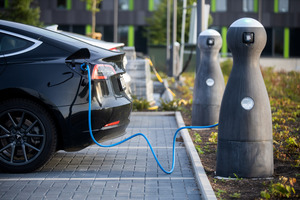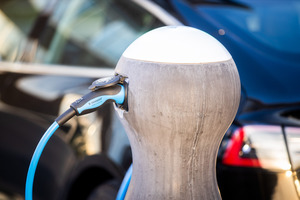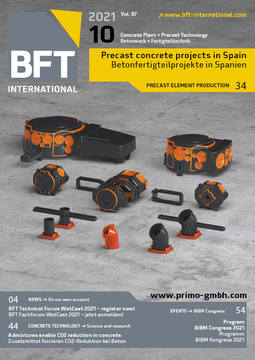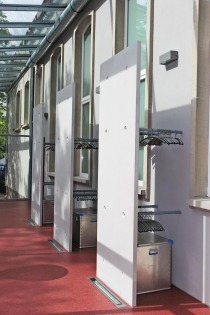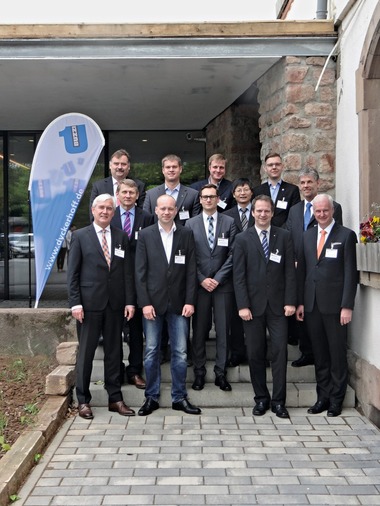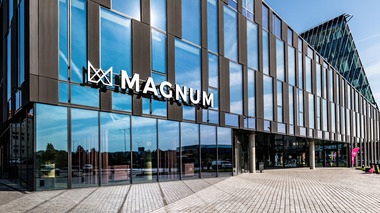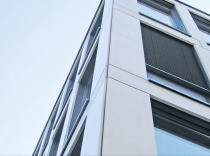Modern charging stations made of Dyckerhoff Nanodur
The name of Osnabrück-based Pion AG says it all: “pion” is French for “playing piece”, and that’s exactly what the stylish charging stations for electrical vehicles look like. They have meanwhile been installed in many different locations: large metal boxes that are not really pleasing to the eye. The owners of the Osnabrück-based startup company wanted to change that. “Design for eternity” is what Pion AG promises in the brochure presenting the new concrete charging stations. Since 2016, an idea has turned into a product that blends in well with the environment, is safe and, above all, intuitive to use, and has a long service life. The organic shape – a previously unknown geometry for charging stations – was decided upon very quickly. The material was also soon identified: concrete was to protect the sensitive technology – in particular due to its high strength and durability. In addition, the optional use of titanium dioxide allows it to contribute towards the reduction of nitrogen oxides.
During the development stage, tests were carried out with a variety of different concretes. A concrete based on the Nanodur Compound 5941 premium binder from Dyckerhoff was the only material to fully satisfy the requirements of the developers. The reasons for this are ease of processing, excellent de-aeration dispensing with the need for additional compaction, its natural color and exceptionally high strength, says Stephan Lange, chief developer at Pion. The excellent support provided by the Wilhelm Dyckerhoff Institute also contributed to the fact that they believed to be in good hands at Dyckerhoff right from the start, Stephan Lange continues. The “pions” have now been manufactured for a year using the special binder from Dyckerhoff.
Lifestyle product and modern street furniture
One “pion” made of high-strength concrete, weighing 140 kg at a height of 1.33 m and a base diameter of 49 cm, requires 65 kg of binder. Its wall has a thickness of only 20 mm at the thinnest point. It is cast in three separate parts comprising the upper part of the housing (dome), the technology module and the bottom part of the housing, and after hardening is bolted together and fitted with the desired technology. Similar to a modular system, the charging stations can be configured for a variety of different requirements – from the simplest model, “Easy Loading”, all the way to being controlled via an energy management system that takes into account all of the standard payment functions. As a result, they are interesting not only for companies operating a large number of vehicles to be charged but, due to its calibrated measuring system, also for use in the municipal sector.
Two vehicles can be charged simultaneously at a single charging station either via a charging socket or via a charging cable. The charging station is directly connected to the power grid. The dome is fitted with one each powerful LED per charging point indicating the current state of the station: green indicates that charging station is free, blue shows the charging process, and red indicates that an error has occurred. Contrary to the standard stand-alone concrete bases, Pion additionally supplies concrete bases that are not embedded in the ground but remain mobile, thus enabling the charging stations to easily be operated in a different location.
The product of the Osnabrück-based company reached the finals of the “The smarter E Award” competition in 2019 in the Smart Renewable Energy category, which is awarded annually to companies from around the world offering intelligently networked concepts and solutions for the efficient generation, storage and use of energy. The developers at Pion AG do not see the smart charging station as a mere utility but as a “lifestyle product” and “modern street furniture”. They are doubtlessly an eye-catcher. The company also uses Nanodur Compound 5941 to produce wall-mounted chargers. Charging stations in different designs are currently in the development stage.

